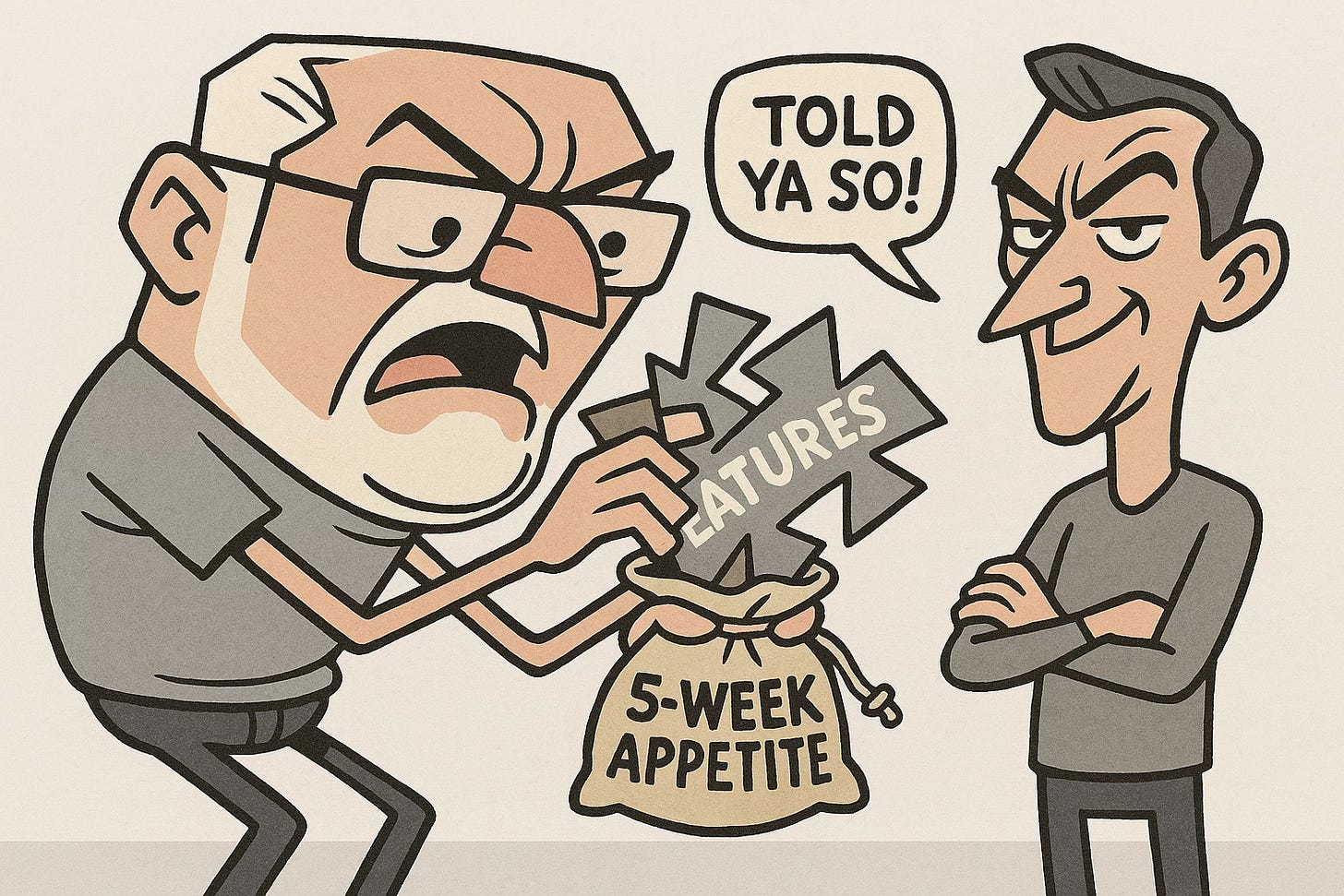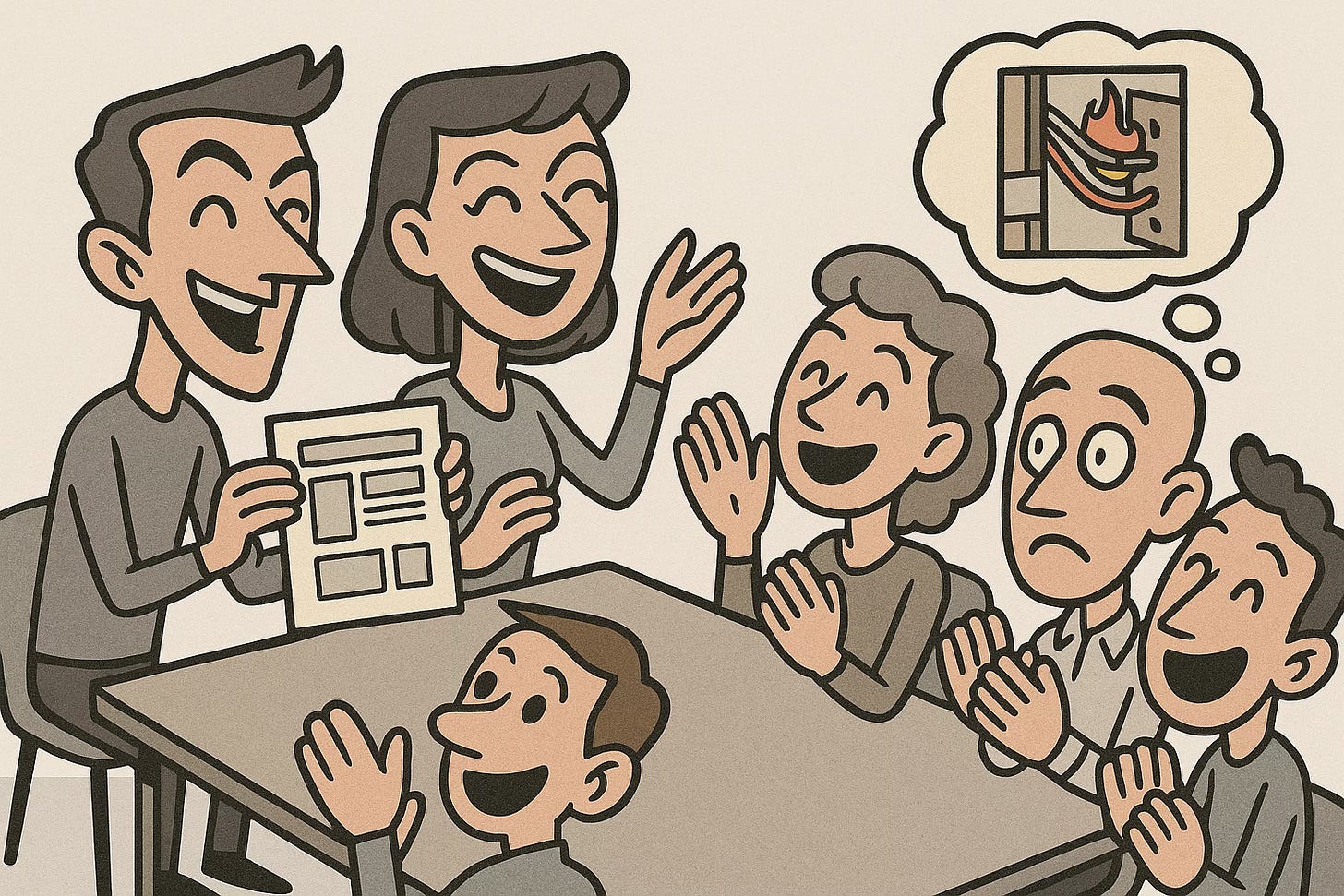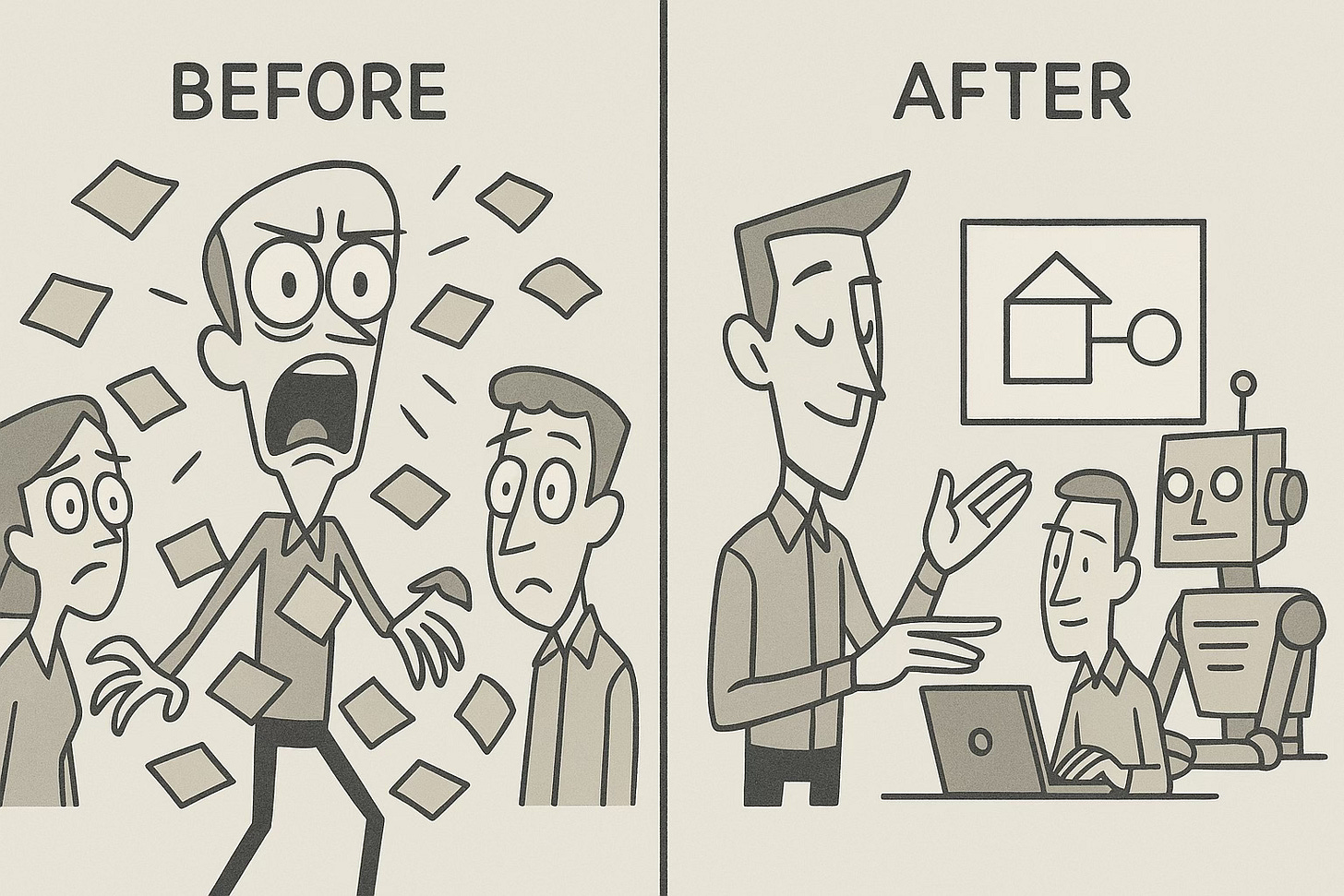Meanwhile, as everyone's gone completely AI-crazy in the development world, something fascinating is happening in the shadows - the Shape Up method from 37signals (the folks who created Basecamp) is experiencing a serious renaissance in 2025. I recently watched Lenny Rachitsky's excellent podcast with Ryan Singer, the creator of Shape Up, and it got me thinking about why this approach is suddenly so relevant again.
The timing couldn't be more interesting. In this era where AI can churn out thousands of lines of code in seconds, we need to focus on what truly matters - understanding WHAT exactly to build. And that's exactly where Shape Up shines.
TL;DR for the busy folks:
Forget everything you've heard about Agile - Shape Up is making a stunning comeback in 2025's AI-dominated dev world. Ryan Singer's methodology from 37signals turns out to be perfectly suited for an era where AI can write code, but humans still need to decide what's worth building. As I discovered listening to Lenny Rachitsky's podcast with Singer, this approach isn't just surviving but thriving precisely because it focuses on the "what" and "why" rather than the "how." Could this 2019 framework be the secret weapon for standing out in today's hyper-competitive product landscape?
What Exactly Is Shape Up?
Shape Up isn't just another development framework collecting dust since its 2019 publication. It's a fundamentally different approach that contrasts sharply with both Scrum and Waterfall.
The method originated from Ryan Singer's experience building Basecamp at 37signals. Instead of the endless estimates and sprint planning of Scrum or the rigid documentation of Waterfall, Shape Up emphasizes working backward from a fixed time budget (an "appetite") and collaboratively "shaping" an idea before giving it to a team to build.
The Four Core Principles
Appetites instead of deadlines: Start by determining the maximum time the business is willing to spend (typically 6 weeks), and fit the solution to it, not the other way around. This creates constraints that drive creativity. As Singer puts it, you determine "how much time is this worth?" instead of "how long will this take?"
Shaping: Intensive work on defining the problem and outlining a solution BEFORE development begins. The result isn't a detailed spec, but a clear idea, often described with fewer than 10 components. This phase de-risks major unknowns. The output is not high-fidelity mockups but sketches and diagrams showing key components and flows.
Betting Table: The shaped idea is given to a team for a fixed amount of time. No preliminary breakdown into tickets - the team figures out implementation details themselves. This preserves autonomy and creative problem-solving. This is where senior leadership "bets" on which shaped ideas are worth pursuing.
Circuit Breaker: If a project isn't on track within the "appetite," it's not extended but canceled and rethought. Tough but effective way to avoid sunk cost fallacy. At Basecamp, this meant canceling projects, but in practice many teams pull projects back into shaping mode to regain clarity.
Why Shape Up Is Perfect for the AI Development Era
Why is Shape Up suddenly super relevant in 2025's AI development landscape? The answer is beautifully logical:
The Focus Shifts from "How" to "What"
With AI handling much of the "how" to write code, our focus shifts dramatically to "what" needs to be built and why. That's precisely what Shape Up concentrates on. The bottleneck and crucial skill are shifting towards clearly defining what should be built and why.
As Ryan Singer mentioned in the podcast with Lenny:
"Shaping is going upstream in the process. Instead of just working on how to effectively refine tickets, we're thinking about how to effectively frame the problem and outline the solution."
Clarity Before Building Is Now Even More Critical
Even with the most advanced AI coding assistants, poorly defined projects with vague goals still lead to impressive amounts of wasted effort. Clarity before development becomes even more crucial. The principle of not starting something unless you can see the end remains vital to prevent wasted effort.
One of the most memorable analogies from the podcast was when Singer compared unclear projects to home renovations:
"It's like having a beautiful rendering of a new bedroom with wall-mounted lamps, but if you haven't checked for electricity in the wall, the cost and time will drastically change. You need to check for the wiring before finalizing design plans."
Collaborative Understanding Is Essential for AI Tools
The collaborative nature of shaping creates shared understanding across the entire team (and for the AI tools they use). Simply telling AI to "build a feature" without a well-formed understanding of the problem is like asking for a disaster.
As Bob Moesta humorously put it (quoted by Singer in the podcast):
"You can't put 10 pounds of crap in a five pound bag."
You can't just take any oversized, poorly-defined project and expect it to be delivered meaningfully in a fixed time frame - even with AI assistance.
Competitive Advantage Through Focus
In 2025's hyper-competitive market, the ability to deliver focused, valuable features quickly has become the difference between success and irrelevance. Shape Up's time-boxed approach forces prioritization of what truly matters.
Product managers in an AI-driven landscape will likely spend less time managing the intricacies of the build process and more time on strategy, problem validation, and ensuring that features deliver real value. The framing stage of Shape Up directly addresses this need.
Adapting Shape Up to Your Team (It's Not One-Size-Fits-All)
Ryan Singer is refreshingly honest about the fact that not every team looks like Basecamp. During the podcast, he mentioned how his wife would overhear him repeatedly saying the same things about applying Shape Up principles to real-world scenarios, which led to the creation of his course, "Shaping in Real Life."
Here are several adaptations or "workarounds" based on the podcast and other sources:
"Shape Up In Real Life"
Singer has shifted his focus to addressing gaps in the original book for teams facing challenges Basecamp didn't have, such as:
Designers who don't code
Difficulties in securing engineering time
Integration with existing company processes
Flexible Time Boxes
While six weeks is often mentioned, the appetite can vary:
Two-week timeboxes for smaller projects
Four-week timeboxes with a cooldown week
The key is being intentional about the time budget
Adapting to Company Cadence
Shape Up can be implemented in larger companies with existing quarterly or six-month cadences:
Teams can operate on shorter timeboxes that align with broader cycles
Consistent delivery of meaningful outcomes matters more than strict alignment with company-wide timelines
Gradual Adoption
Teams can pick and choose elements of Shape Up rather than adopting the entire framework wholesale:
Start with a pilot project on an important problem
Implement the parts that make the most sense for your context
Kick-off Exercise
For teams that aren't all highly senior, Singer recommends:
A kick-off exercise where the building team translates the shaped idea into nine or fewer major implementation scopes
This provides clarity and uncovers potential issues early
Real-World Implementation Advice
Based on Singer's insights from the podcast, here are practical steps for implementing Shape Up in 2025:
1. Start Small
"What usually works best is, okay, we're going to try a pilot project. And what we want to do is, as you said, choose a problem that's important enough to all of us that we think it's going to be worth doing well. And it doesn't have to be six weeks. It could be smaller. Then we do some framing work and try shaping it."
Pick a single project where you can test the methodology without disrupting everything. Look for something important but contained.
2. Adapt to Your Team's Experience Level
"The amount of detail that the team is going to feel helps them is a dial that we can turn depending on who's on the team. If there's a more junior person, they might need more guidance to avoid them feeling lost. Then you can dial it back as they grow."
Not every team is like Basecamp. Use the kickoff exercise for less senior teams to translate shaped ideas into implementation scopes.
3. Involve Engineers in Shaping
"And it only takes a moment to open up the code, find this thing that we're talking about, and really look at it and say, oh, you know, it's more complicated than we thought. And now it's not like, okay, now we're screwed and the project is going to be bigger. Now we can have a really cool conversation about trade-offs before the project starts off."
This is absolutely critical. Engineers who understand your codebase need to be part of shaping sessions to ensure technical feasibility.
4. Focus on Framing First
"If the problem is too fuzzy and big, if the problem is just calendar, then the shaping is going to be this ever-expanding, never-ending thing, and we're not going to be able to get anywhere. So we want to identify the real slice that's valuable first."
Before shaping, clearly define and narrow down the problem. This prevents your shaping process from becoming too broad. Tools like Jobs-to-be-Done can be helpful at this stage.
5. Blend with AI Workflow
Create specific prompts for your AI tools based on your shaped ideas. The clarity from shaping makes your AI interactions far more productive.
The clearly defined components from a shaped project make excellent inputs for AI coding assistants. Your prompts can be more precise, focused, and outcome-oriented.
6. Set Clear Expectations with Stakeholders
"But what we can do is say, we're not going to keep reinvesting in something that we don't understand, you know? So let's take this out of build mode and bring this back into shaping mode, doing a different kind of work to suss out what's fuzzy. That way we don't keep overrunning time."
Help stakeholders understand that this isn't about working faster but about focusing efforts on the right things. Be prepared to hit the circuit breaker when necessary.
7. Don't Force It
"I would say, wait until it hurts more. You know, if the unfamiliarity is kind of the big problem with it, you know, then maybe things are fine. I mean, because it's not like this is the only way. It's more like, I mean, changing is really hard, you know? And if there's a good reason to do it... we can't continue this way."
Don't jump to Shape Up just because it's trendy. Change is hard. Are your current pains severe enough to warrant a workflow overhaul? Be honest about this.
Common Pitfalls to Avoid
Based on Singer's insights, here are some common mistakes teams make when implementing Shape Up:
Isolated Design or Product Docs
"Very often when people try ShapeUp, what I see is a product team creating a bunch of Figma files or a big PRD, and then they give that to a team. But there's so much pushback because the Figma file is not shaped with engineering in the room. So we want all necessary knowledge in the same session."
Avoid creating detailed designs or product requirements in isolation. The "reality check" when these first encounter the engineering team often leads "back to the drawing board."
Too Much or Too Little Detail
Finding the right balance of detail in shaping is crucial. Too much detail constrains the team's creativity; too little leaves them lost. Adjust based on your team's experience level.
Misunderstanding the Circuit Breaker
Many teams struggle with the idea of canceling projects. Instead of seeing it as a failure, view it as a way to avoid wasting resources on something that isn't well understood.
Trying to Shape Everything
Not every task needs to go through the full Shape Up process. Maintenance work, bug fixes, and small enhancements can follow a different track
.
Conclusion: The Renaissance of a Framework
Interestingly, a method designed in 2019 to optimize limited developer time becomes even more relevant in 2025 when that time can be augmented by artificial intelligence. Instead of generating even more code, we can use AI's power to create truly thoughtful and valuable products.
The fundamental principles of Shape Up – clear problem definition, collaborative solution shaping within a time budget, and a focus on delivering value – are not just surviving but thriving in the AI era.
As we navigate this new landscape of AI-augmented development, perhaps the most valuable skill isn't writing code at all, but rather defining what's worth building in the first place. And that's where Shape Up truly shines.







